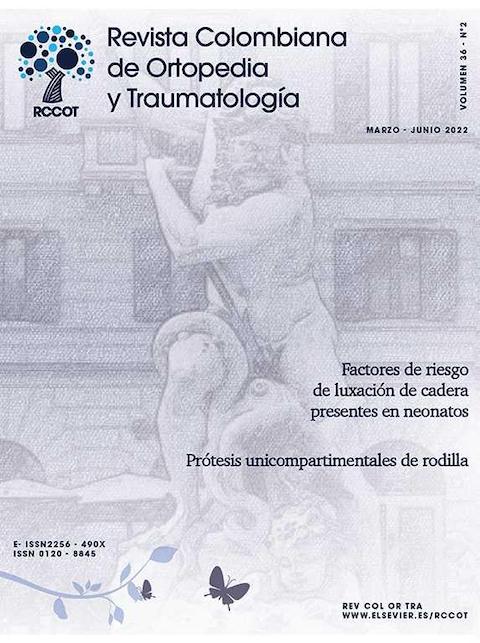Medición del ángulo coronal del ligamento cruzado anterior durante artroscopia
DOI:
https://doi.org/10.1016/j.rccot.2022.05.003Palabras clave:
ligamento cruzado anterior, artroscopia, rodillaResumen
Introducción: La reconstrucción del ligamento cruzado anterior (LCA) es una cirugía muy frecuente, por lo cual hay un amplio interés en saber cómo evaluar la posición y angulación de este ligamento. Se ha reportado ángulo en el plano coronal de 63º-76º tanto en pacientes sanos como en postquirúrgicos.
Objetivo: Determinar el ángulo coronal del LCA in vivo en población adulta colombiana mediante artroscopia.
Materiales y métodos: Estudio de serie de casos (nivel evidencia IV) en el que se incluyeron 47 pacientes mayores de 18 años que fueron sometidos a artroscopia de rodilla entre octubre de 2018 y marzo de 2019. Se obtuvieron imágenes intraquirúrgicas del LCA con lentes de 0º y 30º en los portales transpatelar y anterolateral, respectivamente y se midió el ángulo del LCA en cada artroscopia. En lo que respecta al análisis descriptivo de los datos, se calcularon frecuencias absolutas y porcentajes para las variables cualitativas, y medias, y desviaciones estándar para las cuantitativas.
Resultados: Los ángulos promedio del LCA fueron 57.54º±6.78º y 71º±7.24º con los lentes de 30º y 0º, respectivamente, además se evidenció una angulación constante independientemente del género y la lateralidad de la rodilla, manteniendo una distribución normal en la población estudiada.
Conclusiones: El promedio de los ángulos con cada lente es similar a lo reportado en la literatura mundial, y que los mismos no variaron mucho entre lateralidades y entre hombres y mujeres, y que por tanto se recomienda que en pacientes colombianos sometidos a reconstrucción del LCA la angulación sea de 71.8º en el portal trans-patelar con el lente de 0º o de 57.5º en el portal anterolateral con el lente de 30º.
Descargas
Referencias bibliográficas
Kraeutler MJ, Wolsky RM, Vidal AF, Bravman JT. Anatomy and Biomechanics of the Native and Reconstructed Anterior Cruciate Ligament. J Bone Joint Surg. 2017;99:438-45, http://dx.doi.org/10.2106/JBJS.16.00754.
Shen X, Qin Y, Zuo J, Liu T, Xiao J. A Systematic Review of Risk Factors for Anterior Cruciate Ligament Reconstruction Failure. Int J Sports Med. 2021;42:682-93, http://dx.doi.org/10.1055/a-1393-6282.
Grassi A, Kim C, Muccioli G, Zaffagnini S, Amendola A. What Is the Mid-term Failure Rate of Revision ACL Reconstruction? A Systematic Review. Clin Orthop Relat Res. 2017;475:2484-99, http://dx.doi.org/10.1007/s11999-017-5379-5.
Tapasvi S, Shekhar A. Revision ACL Reconstruction: Principles and Practice. Indian J Orthop. 2021;55:263-75, http://dx.doi.org/10.1007/s43465-020-00328-8.
Reid JC, Yonke B, Tompkins M. The angle of inclination of the native ACL in the coronal and sagittal planes. Knee Surg Sports Traumatol Arthrosc. 2017;25:1101-5, http://dx.doi.org/10.1007/s00167-017-4419-8.
Konarski A, Strang M, Jain N. The natural orientation of the Anterior Cruciate Ligament compared to the tibial plateau on magnetic resonance imaging scans. J Orthop. 2020;22:422-6, http://dx.doi.org/10.1016/j.jor.2020.09.010.
Ahn JH, Lee SH, Yoo JC, Ha HC. Measurement of the graft angles for the anterior cruciate ligament reconstruction with transtibial technique using postoperative magnetic resonance imaging in comparative study. Knee Surgery, Sport Traumatol Arthrosc. 2007;15:1293-300, http://dx.doi.org/10.1007/s00167-007-0389-6.
Estrada-Cruz K, Pérez-Meave JA. Anatomía angular funcional postquirúrgica en pacientes con sustitución del ligamento cruzado anterior con injerto autólogo [Postoperative functional angular anatomy in patients with anterior cruciate ligament with autologous graft]. Acta Ortop Mex. 2018;32:157-62.
Araujo P, Van Eck CF, Torabi M, Fu FH. How to optimize the use of MRI in anatomic ACL reconstruction. Knee Surgery, Sport Traumatol Arthrosc. 2013;21:1495-501, http://dx.doi.org/10.1007/s00167-012-2153-9.
Mayer C, Barner K, Lorimer S, Tran Q, Baer J, Keim Janssen S, et al. Side variations of anterior cruciate ligament coronal angles: Implications for ACL reconstruction. Clin Anat. 2019;32:1102-6, http://dx.doi.org/10.1002/ca.23464.
Vermesan D, Inchingolo F, Patrascu JM, Trocan I, Prejbeanu R, Florescu S, et al. Anterior cruciate ligament reconstruction and determination of tunnel size and graft obliquity. Eur Rev Med Pharmacol Sci. 2015;19:357-64.
Karantanas AH, Zachos VC, Liantsis A, Venouziou A, Malizos KN, Hantes ME. Differences in graft orientation using the transtibial and anteromedial portal technique in anterior cruciate ligament reconstruction: a magnetic resonance imaging study. Knee Surg Sports Traumatol Arthrosc. 2009;17:880-6, http://dx.doi.org/10.1007/s00167-009-0738-8.
Stanford FC, Kendoff D, Warren RF, Pearle AD. Native Anterior Cruciate Ligament Obliquity Versus Anterior Cruciate Ligament Graft Obliquity An Observational Study Using Navigated Measurements. Am J Sports Med. 2009;37:114-9, http://dx.doi.org/10.1177/0363546508323257.
World Medical Association. (?2001)? World Medical Association Declaration of Helsinki. Ethical principles for medical research involving human subjects. Bulletin of the World Health Organization, 79 (?4)?, 373-374. World Health Organization. https://apps.who.int/iris/handle/10665/268312
República De Colombia. Ministerio De Salud. Resolución N◦ 008430 DE 1993. (4 DE OCTUBRE DE 1993). https://www.Minsalud.Gov.Co/Sites/Rid/Lists/Bibliotecadigital/RIDE/DE/DIJ/RESOLUCION-8430-DE-1993
Hassebrock JD, et al. Knee Ligament Anatomy and Biomechanics. Sports Med Arthrosc Rev. 2020;28:80-6, http://dx.doi.org/10.1097/JSA.0000000000000279.
Forriol F, et al. El Ligamento cruzado anterior: Morfologia y funcion. Trauma Fund MAPFRE. 2008;Vol19Supl1:7-18.
Alfonso V, Sancho F. Anatomía descriptiva y funcional del ligamento cruzado anterior. Implicaciones clínico-quirúrgicas. Rev Esp Cir Osteoart. 1992;27:33-42.
Suruga M, et al. Morphological size evaluation of the mid-substance insertion areas and the fan-like extension fibers in the femoral ACL footprint. Arch Orthop Trauma Surg. 2017;137:1107-13, http://dx.doi.org/10.1007/s00402-017-2726-7.
Amis AA. Anterolateral knee biomechanics. Knee Surg Sports Traumatol Arthrosc. 2017;25:1015-23, http://dx.doi.org/10.1007/s00167-017-4494-x.
Siebold R, et al. Femoral Insertions of the Anteromedial and Posterolateral Bundles of the Anterior Cruciate Ligament: Morphometry and Arthroscopic Orientation Models for Double-Bundle Bone Tunnel Placement--A Cadaver Study. Arthroscopy. 2008;24:585-92, http://dx.doi.org/10.1016/j.arthro.2007.12.008.
Joseph SM, et al. Arthroscopic Viewing Position Affects Anterior Cruciate Ligament Reconstruction Femoral Tunnel Length Measurements. Front Surg. 2018;5:16, http://dx.doi.org/10.3389/fsurg.2018.00016.
Hoshino Y, et al. Arthroscopic image distortion-part II: the effect of lens angle and portal location in a 3D knee model. Knee Surg Sports Traumatol Arthrosc. 2016;24:2072-8, http://dx.doi.org/10.1007/s00167-014-3268-y.









